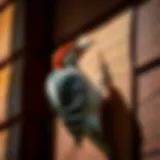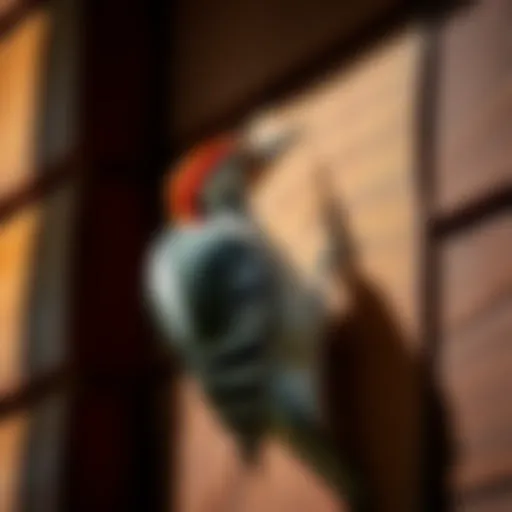Effective Strategies to Prevent Wasp Nests
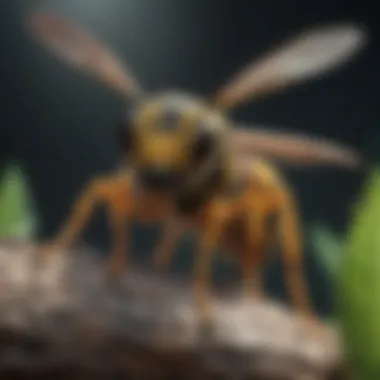

Intro
Dealing with wasps can be more than just a nuisance; it can seriously disrupt one's peace of mind. These insects, despite their often unsung role in the ecosystem, have a knack for invading spaces where we simply want to enjoy the outdoors. Knowing how to prevent wasp nests before they become an issue is crucial for homeowners, especially in areas where these pests tend to thrive. This article explores effective strategies to thwart their nesting activities, turning the tables on these unwelcome visitors.
Pest Identification
Understanding the specific types of wasps you're dealing with is the first step in crafting a prevention plan. Here are some common wasp species often found in residential settings:
- Yellowjackets: These pests are recognizable by their black and yellow stripes. They are often aggressive and will nest in the ground, siding, or even inside walls.
- Bald-faced Hornets: Not true hornets, these creatures often construct distinctive paper-like nests high up in trees or shrubs.
- Paper Wasps: With long legs and a unique umbrella-shaped nest, these wasps can usually be found hanging from eaves or branches.
Signs and Symptoms of Infestations
Spotting early signs of a wasp infestation can make a world of difference. Keep an eye out for:
- Increasing wasp activity around your property, especially in late summer.
- Visible nests that resemble paper balloons or small gray mounds.
- Signs of wasps entering and exiting hidden areas, such as venting or cracks in your home.
Identifying wasps correctly can spare you from unnecessary panic and help you choose the right prevention measures.
Prevention Strategies
Keeping wasps at bay requires a mix of vigilance and proactive measures. Here are some practical tips:
Home Maintenance Tips for Pest Prevention
- Seal entry points: Inspect your home for cracks or openings and seal them with caulk or mesh. Wasp nests often form in hidden spaces.
- Remove food sources: Ensure garbage bins have tight lids, and cover outdoor food while dining outside. Wasps are drawn to sweet and protein-rich foods.
- Limit standing water: Check for any stagnant water sources in gardens or patios that might attract wasps.
Natural Deterrents and Barriers
Using natural deterrents can be an effective strategy for wasp prevention:
- Essential oils: Scents like peppermint or clove can repel wasps. Mix these oils with water in a spray bottle and apply around nests or potential nesting sites.
- Decoy nests: Hanging fake nests can deter wasps from settling in your vicinity; wasps are territorial and may avoid areas that appear occupied.
- Plants that repel: Planting herbs like basil or mint may help keep wasps at a distance as they dislike the strong scents.
Treatment Options
If wasps have already established themselves, prompt action is vital.
Overview of Chemical vs. Natural Treatments
The choice between chemical and natural treatments largely depends on your comfort level and the severity of the infestation:
- Chemical treatments: These are available at pest control stores. They can quickly kill wasps but must be used with caution, considering the environment.
- Natural treatments: Options like soap and water mixes can suffocate wasps, offering a safer method for both the user and the ecosystem.
Step-by-Step Guides for DIY Treatments
- Locate the Nest: Safely find the nest's location; consider doing this at dusk when wasps are less active.
- Prepare Your Treatment: For a natural approach, mix two tablespoons of dish soap in a spray bottle filled with water.
- Spray the Nest: Stand at a safe distance and spray directly onto the nest entrance. Repeat until no wasps are visible.
- Remove the Nest: Once the wasps are gone, wear protective clothing and dispose of the nest.
By employing these methods, homeowners can protect their space and prevent wasps from making a home in places they shouldn’t. An aware and prepared approach can go a long way toward maintaining your comfort and safety.
Understanding Wasp Behavior
Understanding wasp behavior is crucial for homeowners looking to prevent the formation of nests. This knowledge grants insight into their life cycle, nesting preferences, and overall activity patterns, which directly influences prevention strategies.
The benefit of being educated about wasps begins with recognizing various species. Not all wasps are the same. The paper wasp, yellow jacket, and hornets each have unique characteristics and nesting habits. Knowledge of these differences is vital for tailoring your defense strategies.
Also important are the locations where wasps choose to build their nests. These pests are not picky; they can inhabit attics, eaves, and even underground. If you know where to look, you can mitigate risks effectively.
Additionally, understanding seasonal activity patterns can provide valuable timing insights. Wasps are more aggressive in late summer and early fall, and awareness of this can shape when to strengthen preventive measures.
"Study the enemy well; knowledge is the best defense."
On the whole, grasping wasp behaviors, from what drives them to where they settle, is foundational to keeping your home safe from unexpected nests.
Identifying Potential Nesting Areas
Identifying potential nesting areas is a pivotal first step in keeping wasps at bay. Understanding where wasps tend to establish their homes not only allows homeowners to effectively mitigate risks but also fosters a proactive mindset. By knowing these hotspots, one can prepare and protect their environment early on, ensuring fewer surprises when wasp season rolls in.
Common Nesting Sites Around Homes
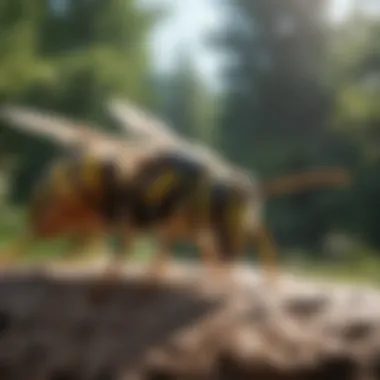

Wasps have a knack for choosing specific locations that offer shelter and a degree of safety from predators. The more familiar you become with these spots, the better equipped you'll be.
- Eaves and Roof Overhangs: Many wasps like to build their nests high up where they feel they can go about their business unnoticed. These spots often provide a perfect nook for queen wasps seeking a site to lay eggs.
- Sheds and Garages: Dark spaces stacked with old tools, lumber or garden supplies can be inviting. Wasps prefer these areas because they have the cover they need to construct a nest.
- Under Decks or Porches: If you’ve got a porch, it could be a hidden haven for wasps. The shaded space and minimal disturbance make it an appealing location.
- Tree Branches: Wasps will sometimes utilize tree branches, especially those that are previously hollowed out or weakened. It's worth checking your trees regularly during the warmer months.
By scouring these common areas around your home, you’ll be better informed.
Signs of Wasp Activity
Observing signs of wasp activity is crucial. If you notice them buzzin' around, it’s best to sit up and take notice:
- Frequent Sightings: Spotting wasps frequently in and around your yard is a tell-tale sign. If you see a pattern of activity on nice days, take it as a cue that they might be scouting for nesting sites.
- Aggressive Behavior: Wasps can show aggression when someone approaches their nesting area. If they start dive-bombing near specific locations, there's a likely nests nearby.
- Nest Building: Seeing any form of construction—be it a small paper-like structure or the beginnings of a larger nest—means you're in the danger zone.
- Dead Insects: The remnants of dead insects can indicate wasp presence as they often prey on insects to feed their young. Keeping an eye out for these can alert you to potential nests.
Acting swiftly on these signs can help thwart wasp infestations before they escalate.
Assessing Risk Factors
It’s advisable to take a step back and evaluate the risk factors that might be increasing your odds of wasps nesting:
- Environmental Conditions: Warm and humid conditions can be a boon for wasp activity. If you live in an area with flowers, trees, and plants, be cautious. These attract bugs, which subsequently draw wasps looking for food.
- Source of Food: If your home has open garbage cans or is near outdoor eating spaces, it becomes a feast for these pests. Ensure bin lids seal securely and tackle any spills promptly.
- Habitat Proximity: If you’re situated near open fields, wooded areas, or pastures, there's a chance wasps may seek to migrate closer to residential areas. Try to create distances through barrier methods.
Understanding these factors can allow you to take preemptive measures and address the underlying issues before wasps make your home their own.
Timing for Prevention
Preventing wasp nests is not just about addressing the issue when it arises; it’s also about being proactive. Timing plays a crucial role in the effective management and prevention of wasp nests. By understanding when these insects are most active and their nesting cycles, homeowners can take measurable steps to thwart potential infestations before they take root.
By engaging in prevention during the right periods, homeowners can not only minimize risk but also save time and resources later on. Proper timing means a more effective approach to wasp management, allowing one to spends less effort down the line.
Early Spring Interventions
The early spring months mark a significant turning point in wasp behavior. As temperatures start to warm, queens emerge to search for suitable nesting locations. It is during this time that homeowners should be on high alert. Here are some strategies to consider:
- Inspection of Property: Conduct thorough inspections in your yard and near structures. Look for potential nesting sites. Common spots include overhangs, sheds, and wall cavities.
- Remove Food Sources: Clear away any food waste and secured trash. Wasps are naturally attracted to sugary substances, especially as they begin their quest for nest-building materials.
"Early intervention is the name of the game; miss the boat and you may find yourself in a sticky situation later on."
By being vigilant and taking these steps in early spring, you can significantly reduce the chances of wasps coming around and setting up camp.
Maintaining Vigilance During Summer
As summer heats up, the activity of wasps increases exponentially. It’s a critical period where nest-building can quickly spiral out of control. Maintaining vigilance is key.
- Regular Monitoring: Regularly check trees, bushes, and your home for signs of nests. Often, a nest might start as just a few wasps visible around a potential site.
- Educate Family Members: Teach everyone in your household to recognize wasp activity and proper reporting. The sooner someone spots a wasp or signs of a nest, the better.
- Trim Back Dense Vegetation: Keeping outdoor areas well-trimmed discourages wasps from finding secluded spots to nest, as they prefer overgrown areas.
Your proactive measures during the summer months can mean the difference between a minor inconvenience and a full-blown infestation.
Fall and Nesting Cycle Recognition
By the time fall rolls in, the dynamics shift. Although many wasps are nearing the end of their lifecycle, the nests might still pose a hazard. Recognizing this phase helps in planning the necessary responses.
- Detecting Activity Levels: As temperatures cool, many wasps become less active. However, watch for late-season nests. Wasps can become agitated when disturbed, posing a risk to anyone nearby.
- Plan for Nest Removal: If any nests have been established, fall is often the most suitable time to organize removal before the winter. This prevents them from returning in spring.
As the seasons change, using your knowledge about wasp nesting cycles prepares you better to tackle upcoming challenges. By staying attentive and monitoring these patterns, a homeowner can effectively diminish the likelihood of wasps becoming a problem.
Natural Deterrents
When it comes to preventing wasp nests, natural deterrents hold significant value. They provide effective means for homeowners seeking to manage wasp activity without resorting to harsh chemical solutions. Awareness of plant-based repellents, environmental alterations, and essential oils can create a less inviting setting for these pests, thereby minimizing the chances of nest formation.
Plant-based Repellents
Utilizing plant-based repellents can serve as a cornerstone in any wasp prevention strategy. Certain plants have natural properties that wasps find offensive. For instance, marigolds and mint are commonly known for their ability to repel these insects. Positioning these plants around the home not only enhances the landscape but also acts as a natural barrier.
Consider this: planting a border of mint around your garden edges can serve a dual purpose. It keeps the wasps at bay while also providing a refreshing aroma. Additionally, infusing vinegar with peppermint or clove oil and spraying it in potential nesting areas can further deter them. This approach is particularly useful as it avoids the use of synthetic chemicals, which can pose health risks to pets and family members.
Creating Unpleasant Environments
Creating an environment that is less appealing to wasps can be straightforward yet highly effective. A tidy garden, devoid of overripe fruits and leftover food, sends a clear message to these pests that they are not welcome. Furthermore, keeping garbage bins tightly sealed and triggering minor cover-ups of food waste is crucial.
In addition, placing decoys like fake wasp nests in strategic areas can trick wasps into believing the territory is already claimed. Wasps tend to be territorial and may shy away from nesting near an existing colony, even if it’s a mere decoy. This technique is particularly practical in early spring when the wasps are scouting for viable nesting sites.
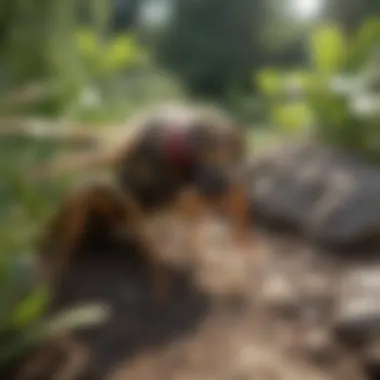

Utilizing Essential Oils
Essential oils offer another layer of prevention against wasp infestations. The scents of oils such as peppermint, clove, and lemongrass are suffocating to their olfactory senses. By diluting these oils in water and employing a spray bottle, homeowners can create a simple deterrent spray. Spraying around window frames, doorways, and other potential entry points can provide a barrier against unwanted wasp guests.
"Natural methods may require a bit more effort and patience, but they ultimately work in favor of your garden and family health."
With these methods, utilizing essential oils not only keeps these pests at bay but also adds a pleasant fragrance to the air. It’s vital, however, to reapply these sprays after rain or heavy winds to maintain efficacy. By incorporating these natural strategies, homeowners can contribute to a wasp-free environment.
In summary, natural deterrents offer a viable path to managing wasp populations. By implementing plant-based repellents, creating unpleasant environments, and utilizing essential oils, individuals can strike a balance between effective pest control and maintaining a healthy ecosystem around their homes. This comprehensive approach adds depth to any prevention strategy.
Chemical Solutions and Precautions
When it comes to preventing wasp nests, chemical solutions offer a powerful toolkit. They can drastically reduce the likelihood of wasps settling in your vicinity. However, opting for chemical deterrents comes with its own set of responsibilities and considerations.
Utilizing chemicals is not just about spraying and forgetting. It's about understanding the products, their active ingredients, and how they interact with the environment. Effective management of wasp populations involves being mindful of safety measures and being aware of the potential consequences of their use. The aim here is to enhance effectiveness while ensuring the safety of pets, children, and beneficial insects.
Types of Chemicals Used for Deterrence
Several chemical options are available for those aiming to keep wasps at bay. Here are some commonly used products:
- Insecticides: Includes both sprays and granular forms that target wasps specifically.
- Repellents: Often contain natural extracts or chemicals designed to ward off wasps without necessarily killing them.
- Traps: These typically involve a baited solution that lures wasps and traps them inside.
Choosing the right product is key. Not all chemical solutions are created equal. Some might be more suited for specific types of wasps or particular locations around your home. Informing yourself can make a significant difference in the effectiveness of your preventive measures.
Safety Measures When Using Chemicals
Safety cannot be overstated when using chemical solutions. Here are some essential precautions:
- Read Labels Carefully: Understanding the usage instructions and safety guidelines is paramount. Different products come with varying levels of toxicity and application methods.
- Wear Protective Gear: Don't skimp on the gloves and masks. Protecting your skin and respiratory system can prevent unintended exposure.
- Avoid Windy Days: Spraying during gusty conditions can lead to unintended exposure. It's best to work in calm weather to ensure the chemicals hit their target.
Minimizing risk is crucial, not just for you but for the surrounding ecosystem too. Failing to take appropriate safety measures can result in harmful outcomes.
Application Techniques for Effectiveness
Simply applying a chemical solution isn’t enough; the application technique can drastically affect efficacy:
- Targeting the Nest: Apply sprays directly onto nests at dusk or dawn when wasps are less active.
- Distance Matters: Ensure you maintain a safe distance from nesting sites during application, utilizing long nozzles if necessary.
- Follow Up: Monitoring the treated areas afterward is essential. If wasps reappear, a follow-up treatment may be needed.
"Regular inspections and a strategic approach can make all the difference in managing wasp populations."
In summation, while chemical solutions can provide effective deterrents against wasp nesting, they are most impactful when used thoughtfully. Ensuring safety and refining application techniques not only enhances effectiveness but also aligns with responsible pest management practices.
Physical Barriers and Exclusion Techniques
Physical barriers and exclusion techniques are key to effective wasp nest prevention. By creating a protective shield around your home, you can significantly reduce the chances of wasps making your property their nest. This proactive approach involves not only sealing off potential entry points but also making your yard less inviting for these pests. Let’s dig deeper into the specific elements that constitute effective physical barriers, their benefits, and critical considerations.
Sealing Entry Points in Structures
One of the most straightforward yet effective ways to deter wasps is to seal entry points in your home. Wasps are adept at finding small cracks and openings in structures where they can make themselves at home. Here are some strategies:
- Inspect Regularly: Check for gaps in windows, doors, and the foundation. Areas where pipes enter the home also need special attention. Seasonal changes can cause materials to expand and contract, creating new openings.
- Use Appropriate Materials: For sealing gaps, materials like caulk or expandable foam work well. Ensure these materials are applied thoroughly, as even the tiniest opening can be an invitation for wasps.
- Screens on Vents and Windows: Install fine mesh screens in attics, vents, and windows. Not only do they provide protection against wasps, but they also keep out other pests.
"An ounce of prevention is better than a pound of cure." Sealing entry points is the first line of defense against unwanted guests.
Installing Wasp Deterrent Devices
In addition to sealing entry points, installing deterrent devices can further protect your home. These devices come in various forms and help dissuade wasps from nesting nearby.
- Wasp Decoys: Hanging fake nests can trick wasps into believing another colony has claimed the territory. Wasps are typically territorial, so this method exploits that behavior. You can find many types of these decoys in home improvement stores.
- Electronic Deterrents: Some homeowners opt for electronic devices that use sound waves or vibrations to repel wasps. These methods can be particularly effective in larger outdoor spaces.
- Visual Barriers: Strands of metallic tape or reflective objects can disorient and repel wasps. They tend to avoid areas that are cluttered with visual disturbances, so a little creativity here can go a long way.
Landscaping Strategies to Reduce Attractiveness
Your yard's landscape can either attract or deter wasps. By making some strategic changes, you can minimize the chances of them nesting close to your home.
- Regular Maintenance: Keep your garden tidy. Wasps are drawn to overripe fruit and sugary spills. Clean up any fallen fruit from trees and remove any open trash cans that could provide food sources.
- Choose Wasp-Resistant Plants: Certain plants are less appealing to wasps. For instance, plants like mint and marigolds can help keep wasps at bay become they prefer other types of vegetation.
- Limit Standing Water: Wasps are drawn to water sources as well. Ensure that there’s no stagnant water in your yard, such as in bird baths or puddles, which can attract them.
By implementing these physical barriers and exclusion techniques, you can significantly reduce the risk of wasps forming nests on your property. Each method, from sealing entry points to landscaping strategies, works together to create an environment less favorable to these pests, making your home a safer and more comfortable space.


Monitoring and Ongoing Management
Monitoring and managing wasp activity is crucial for effective prevention of nest formation. This ongoing process involves not just a one-time inspection, but a continuous effort to keep tabs on the situation. Why is this so important? First, it allows you to catch potential nesting problems early, which is paramount. With wasps, an ounce of prevention is worth a pound of cure. If you can spot signs of them moving in, you can take action before they set up shop and create a nest that could become a nuisance down the line.
The benefits of ongoing monitoring are substantial. It enables homeowners to be proactive rather than reactive, which is always a favorable position to be in. Furthermore, understanding seasonal behaviors helps in aligning your strategies with when these pests are most active, promoting effective management.
"Regular monitoring not only keeps your space safe, but it also gives you the upper hand against wasps before they become a big problem."
Regular Inspection Practices
Regular inspections are like a safety net—catching issues before they spiral out of control. A thorough check around your home should be part of your seasonal household routine. Focus on potential nesting spots such as:
- Eaves and gables
- Hollowed-out trees and shrubs
- Under decks or porches
- Sheds and garages
When inspecting, look for any signs of activity. A single wasp buzzing around could mean more are lurking nearby. Observing wasps carrying food or building materials back to a site can give you a heads-up about a possible nest formation.
It may also be helpful to set a schedule for regular visits to areas that were previously inhabited by wasps, as they may revisit or establish new nests in the same location if the area remains undisturbed.
Adapting Prevention Strategies Seasonally
Different seasons call for different strategies. In spring, your main focus should be on identifying potential nesting sites, as this is when many species begin their search for a home. As the temperature warms, wasps become more active, and so should you. Preparing in advance can make all the difference.
- Spring: Prioritize inspections and remove potential nesting material.
- Summer: Maintain vigilance; as nests grow, so does the likelihood of aggressive behavior. Keep an eye on areas where you see increased wasp activity.
- Fall: Monitor nests closely since many wasps become more desperate in their search for sustenance as the weather cools.
Being flexible with your strategies according to the changing environment can ensure that you remain a step ahead.
Engaging Professionals for Assistance
If you're feeling overwhelmed or simply don’t have time to manage wasps, don’t hesitate to call in the pros. Pest control specialists have the experience and tools necessary to handle wasp problems effectively. They can also offer tailored strategies suited to your specific situation, which can save time and hassle in the long run.
When choosing a pest control expert, consider their reputation and ask for recommendations. A professional can help identify nests you may have missed and provide solutions that are safe and effective.
Bringing in professionals not only reduces your workload but also gives added peace of mind, knowing the job is handled by an expert.
In summary, keeping an eye on wasp activity through regular inspections, adapting prevention efforts with the seasons, and knowing when to reach out for help can significantly aid in avoiding the troublesome formation of nests around your home.
Common Misconceptions About Wasp Control
Addressing common misconceptions about wasp control is crucial for effective management. Many homeowners harbor misunderstandings that not only endanger their own safety but also complicate pest control efforts. Recognizing these misconceptions can provide valuable insights that transform the approach individuals take towards managing wasps. Through this exploration, we can shed light on the realities of wasp behavior and the most effective control methods available.
Myths Surrounding Wasp Aggression
One prevalent myth suggests that all wasps are aggressive and pose a serious threat to humans. This notion often leads to unnecessary panic and can result in hasty actions that might provoke these insects. In reality, the aggression of wasps largely depends on the species in question, the time of year, and their immediate context. For instance, yellowjackets, which are often mistaken for common wasps, tend to display aggressive behavior when defending their nests, especially late in the summer when food sources dwindle. However, many wasps, such as paper wasps, are relatively docile and only become a threat if provoked.
Understanding the right circumstances that trigger aggression can help reduce fear and lead to more nuanced control strategies. Educating oneself about local wasp species and their behavior fosters a calmer mindset and a more effective response to any potential nest threats.
Debunking Misbeliefs About DIY Control
Another misconception is that DIY methods are sufficient for controlling wasp populations efficiently. While some home remedies may offer temporary relief, they often fall short when it comes to long-term management. Many people think that simply spraying wasps with household products or using traps will solve the problem. Unfortunately, such tactics may only kill a few wasps and leave the nest intact, allowing the colony to rebound quickly.
Moreover, home remedies vary significantly in effectiveness. Some popular solutions—like vinegar or soap-based sprays—might yield mixed results, and improper application can lead to alarming situations, especially when dealing with angry wasps.
It's vital to recognize that professional pest control services possess the expertise to handle wasp infestations more safely and thoroughly. They can assess the situation accurately and determine the most effective course of action, which in many cases is a well-planned extermination or relocation process.
The Reality of Natural Solutions
Finally, there’s a common belief that natural solutions alone can provide a reliable means of wasp control. Some homeowners rely on the idea that planting certain herbs or using vinegar will prevent wasps from nesting in their property. While these methods may indeed deter some wasps, they are rarely a standalone solution.
Natural repellents can work effectively in combination with other strategies, but relying solely on them often leads to disappointment. It’s essential to understand that while herbs like mint or plants like marigold may have some repelling properties, they cannot assure complete protection or elimination of wasps.
Recognizing these misconceptions and understanding the true nature of wasp behavior and control methods allows homeowners to approach nest prevention with a clearer mind. It empowers individuals to make informed decisions on managing wasps, creating a safer living environment while fostering a balanced relationship with nature.
The End and Final Thoughts
Summarizing Effective Prevention Methods
The prevention techniques boil down to several critical practices:
- Timing: Being vigilant during early spring when wasps begin their nesting, as well as monitoring through the summer and autumn months.
- Habit Awareness: Identifying areas around the home that may attract wasps, such as gardens with flowering plants or untreated wood.
- Using Natural Deterrents: Leverage plants and essential oils known to repel wasps, which can serve as an effective and environmentally friendly strategy.
- Physical Barriers: Implementing physical measures to close off entry points to buildings or outdoor spaces.
- Regular Monitoring: Conducting routine inspections for any signs of wasp activity can prevent a full-blown infestation.
By adopting these strategies collectively, homeowners can ensure a wasp-friendly environment is far removed from their living spaces.
Emphasizing Safety and Awareness
Furthermore, safety can’t be overlooked. Engaging in preventive practices not only protects from potential stings but also fosters a sense of control. Encouraging family members, especially children, to be cautious around potential nesting areas is crucial.
"An ounce of prevention is worth a pound of cure."
Utilizing the preventive measures discussed, individuals can cultivate a safer home environment. Knowing when and how to act, combined with community awareness about wasp behavior, enhances the family's collective resilience against these pests.
